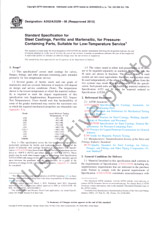We need your consent to use the individual data so that you can see information about your interests, among other things. Click "OK" to give your consent.
ASTM F1693-17
Standard Guide for Consideration of Bioremediation as an Oil Spill Response Method on Land
Translate name
STANDARD published on 1.8.2017
The information about the standard:
Designation standards: ASTM F1693-17
Note: WITHDRAWN
Publication date standards: 1.8.2017
SKU: NS-804598
The number of pages: 5
Approximate weight : 15 g (0.03 lbs)
Country: American technical standard
Category: Technical standards ASTM
The category - similar standards:
Pollution, pollution control and conservationPetroleum products in general
Annotation of standard text ASTM F1693-17 :
Keywords:
bioaugmentation, bioremediation, biostimulation, composting, oil landfarming,, ICS Number Code 13.020.40 (Pollution, pollution control and conservation),75.080 (Petroleum products in general)
Additional information
| Significance and Use | ||
|
3.1 The purpose of this guide is to provide remediation managers and spill response teams with guidance on bioremediation. 3.2 Bioremediation is one of many available tools and may not be applicable to all situations. This guide can be used in conjunction with other ASTM guides addressing oil spill response operations as well as options other than bioremediation. |
||
| 1. Scope | ||
|
1.1 The goal of this guide is to provide recommendations for the use of biodegradation enhancing agents for remediating oil spills in terrestrial environments. 1.2 This is a general guide only, assuming the bioremediation agent to be safe, effective, available, and applied in accordance with both manufacturers' recommendations and relevant environmental regulations. As referred to in this guide, oil includes crude and refined petroleum products. 1.3 This guide addresses the application of bioremediation agents alone or in conjunction with other technologies, following spills on surface terrestrial environments. 1.4 This guide does not consider the ecological effects of bioremediation agents. 1.5 This guide applies to all terrestrial environments. Specifically, it addresses various technological applications used in these environments. 1.6 In making bioremediation-use decisions, appropriate government authorities must be consulted as required by law. 1.7 This standard does not purport to address all of the safety concerns, if any, associated with its use. It is the responsibility of the user of this standard to establish appropriate safety, health, and environmental practices and determine the applicability of regulatory limitations prior to use. In addition, it is the responsibility of the user to ensure that such activity takes place under the control and direction of a qualified person with full knowledge of any potential or appropriate safety and health protocols. 1.8 This international standard was developed in accordance with internationally recognized principles on standardization established in the Decision on Principles for the Development of International Standards, Guides and Recommendations issued by the World Trade Organization Technical Barriers to Trade (TBT) Committee. |
||
| 2. Referenced Documents | ||
|
We recommend:
Technical standards updating
Do you want to make sure you use only the valid technical standards?
We can offer you a solution which will provide you a monthly overview concerning the updating of standards which you use.
Would you like to know more? Look at this page.




 Cookies
Cookies
